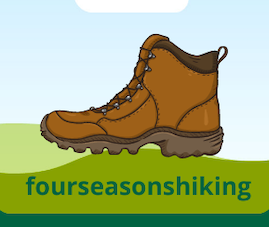Preparation is key to a great hiking experience. Start by researching your route thoroughly. Look up trail reviews, difficulty levels, and landmarks. Knowing what to expect helps in planning the journey better.
Inform someone you trust about your hiking plans. Share details like the trail you will be on, the expected duration, and your estimated return time. This step is crucial in case of emergencies.
Estimation is important. Have a clear idea of how long the hike will take, including breaks. This helps in packing enough supplies and not getting caught by darkness or unexpected weather changes.
Weather conditions can change rapidly, especially in mountainous areas. Check the forecast before heading out and be prepared for sudden changes. Dress in layers and pack a waterproof jacket. Hypothermia can be a real threat if conditions turn cold and wet.
Essential Gear for a Cautious and Enjoyable Hike
One of the most critical aspects of hiking is making sure you have the right gear. A baseplate compass and topographic maps are essential. These tools help you navigate through unfamiliar terrain. Make sure the maps cover not just your hiking route but also adjacent areas. Knowing how to use these tools is just as important. Practice near home before heading onto the trail. Plenty of tutorial videos can guide you through mastering map and compass skills.
Proper clothing for the season makes a huge difference. In warmer weather, lightweight, moisture-wicking fabrics keep you cool and dry. During cooler hikes, layers are your best friend. Opt for a base layer for moisture control, an insulating layer for warmth, and an outer layer to shield against wind and rain.
Waterproof rain gear with ventilation is a must-have. Unexpected showers can not only make you uncomfortable but also lead to hypothermia. Choose gear that is both waterproof and breathable to stay dry without overheating.
Your feet are your primary mode of transportation, so take good care of them. Invest in a good pair of hiking boots that provide support and grip. Don’t forget high-quality hiking socks to prevent blisters. Carry a basic foot care kit with bandages and blister pads.
Packing smart gear ensures you’re prepared for various conditions on the trail. Being well-equipped can make the difference between a challenging hike and an enjoyable adventure.
Navigating the Trail Safely
Knowing how to navigate the trail is essential for both safety and enjoyment. Begin by using your map and compass effectively. Before you start your hike, take time to familiarize yourself with the route. Identify key landmarks and trail markers that you should look out for while hiking.
Practicing navigation skills before the hike is a smart move. Consider going to a local park or an area near your home where you can practice using the map and compass. This will boost your confidence and proficiency in using these tools on the actual hike.
While on the trail, it’s advisable to stay on marked paths. Veering off-trail can lead to getting lost or disturbing the natural habitat. Pay attention to trail markers, which are often placed at regular intervals to guide hikers.
Carrying a GPS device as a backup can provide an extra layer of safety. Make sure it’s fully charged and that you know how to use it. However, never rely solely on electronic devices since they can fail or lose signal in remote areas.
Recognizing trail markers and signs is crucial. They often provide valuable information about direction, distance, and any potential hazards. Being well-versed in reading and interpreting these markers ensures you stay on the right path and helps you avoid unnecessary risks.
Hydration and Nutrition: Staying Energized and Safe
Proper hydration and nutrition are vital for maintaining energy levels and ensuring safety on the trail. Start by bringing clean water. Water sources along the trail might not always be reliable or safe to drink. A premium water filter is a wise investment. It ensures you can safely consume water from natural sources, safeguarding against water-borne diseases.
Snacks packed with nutrients keep your energy levels up. Think trail mix, energy bars, and dried fruits. These provide quick energy boosts and are lightweight, making them easy to carry. Avoid sugary snacks that can cause energy crashes.
Plan your meal breaks strategically. Regular breaks for eating and hydrating help maintain stamina and prevent fatigue. Ration your supplies so that you have enough to last the entire hike, including some extra for emergencies.
Stay attuned to your body’s signals. Dehydration can sneak up on you, especially in hot weather. Watch for signs like dry mouth, dizziness, or dark urine. Take regular sips of water rather than waiting until you’re thirsty. Likewise, ensure you eat small, frequent meals to keep your energy steady throughout the hike.
Environmental Awareness: Protecting Yourself and Nature
Understanding the environment you’re hiking in can significantly enhance your experience and keep you safe. Weather conditions can change quickly, especially in mountainous or forested areas. Learn to read the clouds and recognize early signs of changing weather, such as sudden drops in temperature or shifts in wind direction. This awareness helps you prepare and react appropriately, reducing the risk of hypothermia and other weather-related issues.
Practicing Leave No Trace principles is crucial. Pack out all your trash, avoid picking plants, and respect wildlife habitats. This ensures the trails remain pristine for future hikers and helps to protect the ecosystem. Remember, the goal is to leave the area exactly as you found it, if not better.
Wildlife awareness is another key aspect. Understand which animals inhabit the area you’re exploring and learn how to avoid encounters. Make noise as you hike to prevent surprising bears or other large animals. Carry bear spray if you’re in bear country, and know how to use it. Secure your food properly to avoid attracting wildlife to your campsite.
Minimizing your environmental impact goes beyond just waste. Stay on designated trails to prevent erosion and damage to vegetation. Set up camp at established campsites whenever possible, and use a camp stove instead of a fire to reduce the risk of wildfires.
Experiencing the Beauty of the Hike Safely
A hike is not just about reaching the destination but also about immersing yourself in the beauty around you. Pause to enjoy the scenic views and natural sounds. Whether it’s the rustling of leaves, the chirping of birds, or a breathtaking vista, these moments enrich your experience.
Taking regular breaks to appreciate your surroundings isn’t just relaxing; it also helps you stay alert and energized. Rest in safe spots where you can soak in the beauty without risking your safety, such as open clearings or designated rest areas.
Capture memorable moments with a camera or phone, but do it safely. Watch your footing while taking photos, and be mindful of your surroundings to avoid accidents. If you’re photographing wildlife, make sure you’re at a safe distance to protect yourself and the animals.
Reflect on your hiking experience. Take a moment to absorb the beauty and tranquility of the trail. These reflections often turn into cherished memories, making the hike something you’ll remember for years to come. Hiking with a sense of caution and respect for nature not only keeps you safe but also enhances the overall experience.
In compliance with the FTC guidelines, please assume the following about links and posts on this site: Any/all of the links fourseasonshiking.com are affiliate links of which I receive a small compensation from sales of certain items.

Learn More, Click the Link Above

I loved this article! Hiking is one of my favorite activities, and it’s always great to see tips on how to stay safe while enjoying the great outdoors. I remember one time when I underestimated the weather on a hike – it started out sunny, but a sudden storm rolled in, and I was so glad I had packed extra layers and a rain jacket just in case. Your point about always letting someone know your plans really resonated with me, too. There have been times when sharing my itinerary with a friend gave me that extra peace of mind. What’s one essential item you never hit the trail without? For me, it’s definitely a good pair of hiking boots – they’ve saved my feet on more than one rocky trail!
Hi, thank you for your comment and experience on the trail. I have had a few of those types of close calls when the weather took a change and am glad I remembered my rain gear. In answer to your question about an essential I always double-check is a Baseplate Compass and needed Topographic maps. Of course, I check my list of essentials before leaving.
Lonnie
This is such a comprehensive guide! I love how you’ve emphasized preparation as the foundation for a successful hike. It’s so true—knowing the trail, checking the weather, and informing someone of your plans are all steps that can’t be overlooked. The part about practicing navigation skills near home before hitting the trail really resonated with me. It’s one of those things that can easily be neglected, but it’s crucial for safety.
Overall, this article is packed with practical advice that’s both thoughtful and easy to follow. It’s definitely something I’ll be keeping in mind for my next hike. Thanks for putting this together!
Thanks for your insightful comment!
Sincerely, Lonnie
Great article, it emphasises the importance of balancing adventure with safety in the outdoors. The advice on essential gear ensures that hikers are well-prepared for a variety of situations, from unexpected weather changes to navigating challenging terrain. The focus on safety highlights the need for awareness and preparedness, which are crucial for both novice and experienced hikers. By stressing the importance of caution alongside enjoyment, this guide encourages a mindful approach to hiking, allowing for a more fulfilling and secure experience on the trails. Thanks
Thank you, Have a safe and meaningful hike!
Lonnie
Hi!
Lonnie, this is an excellent and comprehensive guide for anyone looking to enjoy the great outdoors while staying safe! Your emphasis on preparation, navigation skills, and environmental awareness really drives home the importance of being cautious without sacrificing the joy of the hike. I especially appreciate the detailed advice on essential gear and the practical tips for hydration and nutrition.
I think a lot people think that hiking is just walking through a forest on a trail and don’t take into consideration the dangers that could await them. This post will undoubtedly help many hikers have a more enjoyable and safe experience. Thanks for sharing these valuable insights!
– Scott
Thank you, Scott!
Lonnie